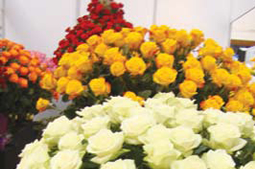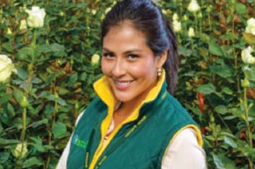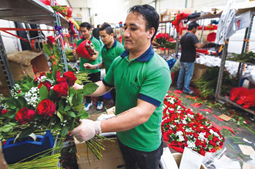Parties, functions an d weddings have been called off and event planners pulled the plug en masse, cancelling all orders of flowers.
d weddings have been called off and event planners pulled the plug en masse, cancelling all orders of flowers.
Flower farmer are staring at disaster if disruptions caused by the coronavirus pandemic continue to august. The pandemic has hit supply chains including major retailers and the event industry.
Local flower farmers discussed with the Floriculture Magazine the devastation the flower farming industry is experiencing due to lack of demand from consumers, cancelled orders from industry outlets and transportation line shutdowns.
“Almost the entire market has collapsed. Technically, our industry has been on lockdown for a while,” said a flower grower, whose business over the last one month has just disappeared.
Since the government declared the pandemic a national disaster and limited public gatherings to 15 people, flower producers ceased almost all of their operations.
Parties, functions and weddings have been called off and event planners pulled the plug en masse, cancelling all orders of flowers.

 His Excellency Daniel Toroitich Arap Moi, Farmer number one for those who grew up in 80s and 90s, a flower farmer and chairman to one of the fastest growing group in the sector, former president and crusader for agriculture as a whole, was promoted to glory on Tuesday, February 4, peacefully. He was 95. All the flowers used during the occasion came from his farms. It was a fitting salute to his dedication, not only to his farms, but to the industry he loved.
His Excellency Daniel Toroitich Arap Moi, Farmer number one for those who grew up in 80s and 90s, a flower farmer and chairman to one of the fastest growing group in the sector, former president and crusader for agriculture as a whole, was promoted to glory on Tuesday, February 4, peacefully. He was 95. All the flowers used during the occasion came from his farms. It was a fitting salute to his dedication, not only to his farms, but to the industry he loved. Due to the impact of the 2019- CoV, the 2020 China International Floriculture & Horticulture Trade Fair (Flower Expo China) will be rescheduled for a new date and venue.
Due to the impact of the 2019- CoV, the 2020 China International Floriculture & Horticulture Trade Fair (Flower Expo China) will be rescheduled for a new date and venue. Pest and disease mapping in any environment has far-reaching effects. Thirty years ago, wild poliovirus was present in more than 125 countries and paralysed 350,000 people every year, primarily young children. Now incredibly targeted tracking and mapping efforts, combined with a global immunisation program by Global Polio Eradication Initiative (GPEI), have reduced the number of cases by more than 99 per cent, saving more than 13 million children from paralysis.
Pest and disease mapping in any environment has far-reaching effects. Thirty years ago, wild poliovirus was present in more than 125 countries and paralysed 350,000 people every year, primarily young children. Now incredibly targeted tracking and mapping efforts, combined with a global immunisation program by Global Polio Eradication Initiative (GPEI), have reduced the number of cases by more than 99 per cent, saving more than 13 million children from paralysis. Downy mildew in roses is caused by an obligate biotrophic oomycete in the family peronosporacea namely Peronospora sparsa. As the scientific name indicates, the production of spores is sparse and therefore this disease is difficult to diagnose and control. It attacks all types of roses both in the greenhouse, nursery and the landscape from potted miniatures to landscape-size roses and even shrub roses. It causes destruction of leaves, stems, and flowers of the infected plant. The pathogen produces zoospores that have flagella they use to “swim” to ideal infection sites. That is why wet plant surfaces make the disease much more prevalent.
Downy mildew in roses is caused by an obligate biotrophic oomycete in the family peronosporacea namely Peronospora sparsa. As the scientific name indicates, the production of spores is sparse and therefore this disease is difficult to diagnose and control. It attacks all types of roses both in the greenhouse, nursery and the landscape from potted miniatures to landscape-size roses and even shrub roses. It causes destruction of leaves, stems, and flowers of the infected plant. The pathogen produces zoospores that have flagella they use to “swim” to ideal infection sites. That is why wet plant surfaces make the disease much more prevalent. Florist Zhong Wenping is usually racing around at valentine’s time, preparing for Valentine’s Day. But this year her flower shop in Jingshan, a small city in central Hubei province, was quiet.
Florist Zhong Wenping is usually racing around at valentine’s time, preparing for Valentine’s Day. But this year her flower shop in Jingshan, a small city in central Hubei province, was quiet. If you are feeling anxious about Valentine’s Day, spare a thought for those working in the floral industry. For them, this is the busiest time of the year, and it’s largely about just one flower: the ubiquitous red rose.
If you are feeling anxious about Valentine’s Day, spare a thought for those working in the floral industry. For them, this is the busiest time of the year, and it’s largely about just one flower: the ubiquitous red rose. The shutdown – costs too high
The shutdown – costs too high  When we moved in, the first thing we had to do is was to clear the bushes and flatten some of the termite hills. We had to design an inroad and gravel it. Getting labour from within was a problem as the locals would prefer to work for a half day in the neighbouring small scale farms than to work the whole day in the flower farm. Getting outside labour was also a problem as the farm is in an isolated place and no housing around. We have since overcome these problems and the farm is now running smoothly.
When we moved in, the first thing we had to do is was to clear the bushes and flatten some of the termite hills. We had to design an inroad and gravel it. Getting labour from within was a problem as the locals would prefer to work for a half day in the neighbouring small scale farms than to work the whole day in the flower farm. Getting outside labour was also a problem as the farm is in an isolated place and no housing around. We have since overcome these problems and the farm is now running smoothly. Irrigation in greenhouses can be a major challenge for some managers because water supply and water quality can considerably affect the success of the crop. However, regular water analysis is not always a common practice in many greenhouses.
Irrigation in greenhouses can be a major challenge for some managers because water supply and water quality can considerably affect the success of the crop. However, regular water analysis is not always a common practice in many greenhouses.